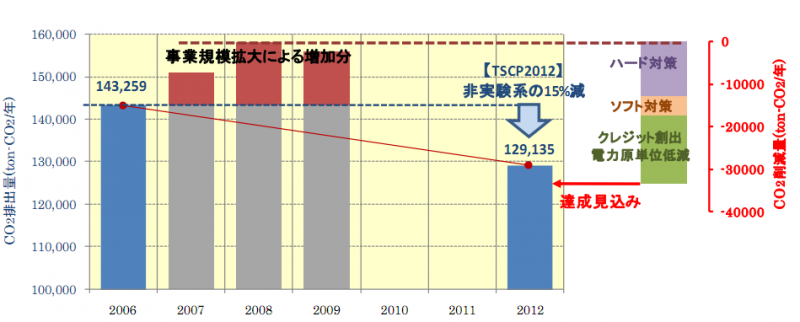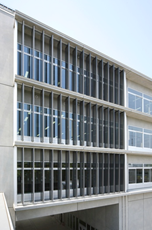JPN
EN
今回講演していただく磯部雅彦先生は、TSCP(東大サステイナブルキャンパスプロジェクト室)室長として、大学の省エネルギー化に取り組んでおられます。
講演に先立ち、TSCPとは何なのか、どのような活動をしているのかについてまとめました。

 TSCP-2030(2012〜2030年度末)
TSCP2030では、2006年度に比べ二酸化炭素排出量の50%削減を目標とし、2012年までにその具体案を検討する。現段階では、TSCP2012の期間中においては、対象とならなかった機器を含め、機器劣化更新時を捉えた高効率化、コストを含めて実用段階になかった技術の導入、更に創エネルギー(太陽光発電など)を本格化させていくとしている。
TSCP-2030(2012〜2030年度末)
TSCP2030では、2006年度に比べ二酸化炭素排出量の50%削減を目標とし、2012年までにその具体案を検討する。現段階では、TSCP2012の期間中においては、対象とならなかった機器を含め、機器劣化更新時を捉えた高効率化、コストを含めて実用段階になかった技術の導入、更に創エネルギー(太陽光発電など)を本格化させていくとしている。
 The purpose of TSCP is to show how to realize the sustainable society by attempting the latest technology or making and trying new technologies in Tokyo University. TSCP is now especially struggling to reduce the emission of the greenhouse effect gas. They made the target of 15% reduction of CO2 emissions by 2012 compared to 2006. And until 2030, they are aiming to cut the half of CO2 emissions compared to 2006.
TSCP succeeded in diminishing the amount of energy consumption in many methods such as shifting all the fluorescent light in some university buildings to more efficient LED light, introducing sensors and the AI (artificial intelligence) to turn off the unneeded lights and so on.
The purpose of TSCP is to show how to realize the sustainable society by attempting the latest technology or making and trying new technologies in Tokyo University. TSCP is now especially struggling to reduce the emission of the greenhouse effect gas. They made the target of 15% reduction of CO2 emissions by 2012 compared to 2006. And until 2030, they are aiming to cut the half of CO2 emissions compared to 2006.
TSCP succeeded in diminishing the amount of energy consumption in many methods such as shifting all the fluorescent light in some university buildings to more efficient LED light, introducing sensors and the AI (artificial intelligence) to turn off the unneeded lights and so on.
 This summer (in 2011), a new building called the 21 KOMCEE (Komaba Center for Educational Excellence) has appeared in Komaba Campus. TSCP led to make the 21 KOMCEE introducing many unique technologies for the comfortable study circumstances and reduction of energy consumption. For example, underground water is used to keep the temperature of rooms comfortable, movable louvers are placed outside the windows to select whether sunlight is reflected or permeates. The AI studies from the past experience and helps the students to use the room effectively.
The 21 KOMCEE is not only a great place for students to study but also a touchstone for making the sustainable society. Judging from the results of introducing technologies in the 21 KOMCEE, other buildings for the sustainable society will be designed and constructed in the future.
(Report by Aoki)
This summer (in 2011), a new building called the 21 KOMCEE (Komaba Center for Educational Excellence) has appeared in Komaba Campus. TSCP led to make the 21 KOMCEE introducing many unique technologies for the comfortable study circumstances and reduction of energy consumption. For example, underground water is used to keep the temperature of rooms comfortable, movable louvers are placed outside the windows to select whether sunlight is reflected or permeates. The AI studies from the past experience and helps the students to use the room effectively.
The 21 KOMCEE is not only a great place for students to study but also a touchstone for making the sustainable society. Judging from the results of introducing technologies in the 21 KOMCEE, other buildings for the sustainable society will be designed and constructed in the future.
(Report by Aoki)
TSCPってなんだ
TSCP(東大サステイナブルキャンパスプロジェクト)とは、2008年に発足した全学的なプロジェクトであり、温室効果ガス排出削減による低炭素キャンパスづくりを当面の最優先課題とし、低炭素キャンパスづくりに取り組んでいる。
3つのコンセプト
・エネルギー需給に関する自律分散協調(見える化) ・省エネルギー・創エネルギーによる低炭素化 ・持続型社会建設に向けた社会連携 を効果的かつ効率的に同時進行する“共進化システム”を構築し,大学という研究・教育機関のモデルケースとして先導的に実現することを目指している。 また、それに加え国内外の大学間のネットワークを通じてこれらの試みを世界的な大学の動きにつなげていくと共に、その動きを社会へと波及させていく。さらに社会における低炭素型の技術と対策の普及をリードすることによって、低炭素社会実現に向けて経済的な波及効果をもたらすことをめざしている。TSCPアクションプラン
TSCPでは低炭素キャンパスに向けた具体的な目標としてアクションプランを作成している。 TSCP-2012(2008〜2012年度末) 2006年度に比べ2012年度には非実験系の二酸化炭素排出量の15%削減を目標にしている。二酸化炭素以下の1〜4を通じて排出削減を行う。- 電力計設置(見える化)による教育・研究活動の増加にともなう排出量増分の抑制
- 省エネ機器への更新支援
- 投資回収年数が機器更新年数の半分以下のもの
- 年間CO2削減量と初期投資額との比が大きいもの
- 回収年数が4年を超える分は,初期投資の補助も考える
- 大型熱源系の省エネ化により約6%削減(初期投資額合計約5億円)
- 照明・個別空調・冷蔵庫などの更新により約7%削減(初期投資額合計約26億円)
- 大量調達による省エネ機器導入普及モデルの作成
- 初期投資が回収でき,その後は光熱水費が削減できるその他対策も含め実施
 TSCP-2030(2012〜2030年度末)
TSCP2030では、2006年度に比べ二酸化炭素排出量の50%削減を目標とし、2012年までにその具体案を検討する。現段階では、TSCP2012の期間中においては、対象とならなかった機器を含め、機器劣化更新時を捉えた高効率化、コストを含めて実用段階になかった技術の導入、更に創エネルギー(太陽光発電など)を本格化させていくとしている。
TSCP-2030(2012〜2030年度末)
TSCP2030では、2006年度に比べ二酸化炭素排出量の50%削減を目標とし、2012年までにその具体案を検討する。現段階では、TSCP2012の期間中においては、対象とならなかった機器を含め、機器劣化更新時を捉えた高効率化、コストを含めて実用段階になかった技術の導入、更に創エネルギー(太陽光発電など)を本格化させていくとしている。
参考
(文責:福井)Professor Isobe and his work in TSCP
Our group is preparing for the lecture by Professor Masahiko Isobe, Head of Tokyo University Sustainable Campus Project (TSCP). The purpose of TSCP is to show how to realize the sustainable society by attempting the latest technology or making and trying new technologies in Tokyo University. TSCP is now especially struggling to reduce the emission of the greenhouse effect gas. They made the target of 15% reduction of CO2 emissions by 2012 compared to 2006. And until 2030, they are aiming to cut the half of CO2 emissions compared to 2006.
TSCP succeeded in diminishing the amount of energy consumption in many methods such as shifting all the fluorescent light in some university buildings to more efficient LED light, introducing sensors and the AI (artificial intelligence) to turn off the unneeded lights and so on.
The purpose of TSCP is to show how to realize the sustainable society by attempting the latest technology or making and trying new technologies in Tokyo University. TSCP is now especially struggling to reduce the emission of the greenhouse effect gas. They made the target of 15% reduction of CO2 emissions by 2012 compared to 2006. And until 2030, they are aiming to cut the half of CO2 emissions compared to 2006.
TSCP succeeded in diminishing the amount of energy consumption in many methods such as shifting all the fluorescent light in some university buildings to more efficient LED light, introducing sensors and the AI (artificial intelligence) to turn off the unneeded lights and so on.
 This summer (in 2011), a new building called the 21 KOMCEE (Komaba Center for Educational Excellence) has appeared in Komaba Campus. TSCP led to make the 21 KOMCEE introducing many unique technologies for the comfortable study circumstances and reduction of energy consumption. For example, underground water is used to keep the temperature of rooms comfortable, movable louvers are placed outside the windows to select whether sunlight is reflected or permeates. The AI studies from the past experience and helps the students to use the room effectively.
The 21 KOMCEE is not only a great place for students to study but also a touchstone for making the sustainable society. Judging from the results of introducing technologies in the 21 KOMCEE, other buildings for the sustainable society will be designed and constructed in the future.
(Report by Aoki)
This summer (in 2011), a new building called the 21 KOMCEE (Komaba Center for Educational Excellence) has appeared in Komaba Campus. TSCP led to make the 21 KOMCEE introducing many unique technologies for the comfortable study circumstances and reduction of energy consumption. For example, underground water is used to keep the temperature of rooms comfortable, movable louvers are placed outside the windows to select whether sunlight is reflected or permeates. The AI studies from the past experience and helps the students to use the room effectively.
The 21 KOMCEE is not only a great place for students to study but also a touchstone for making the sustainable society. Judging from the results of introducing technologies in the 21 KOMCEE, other buildings for the sustainable society will be designed and constructed in the future.
(Report by Aoki)
